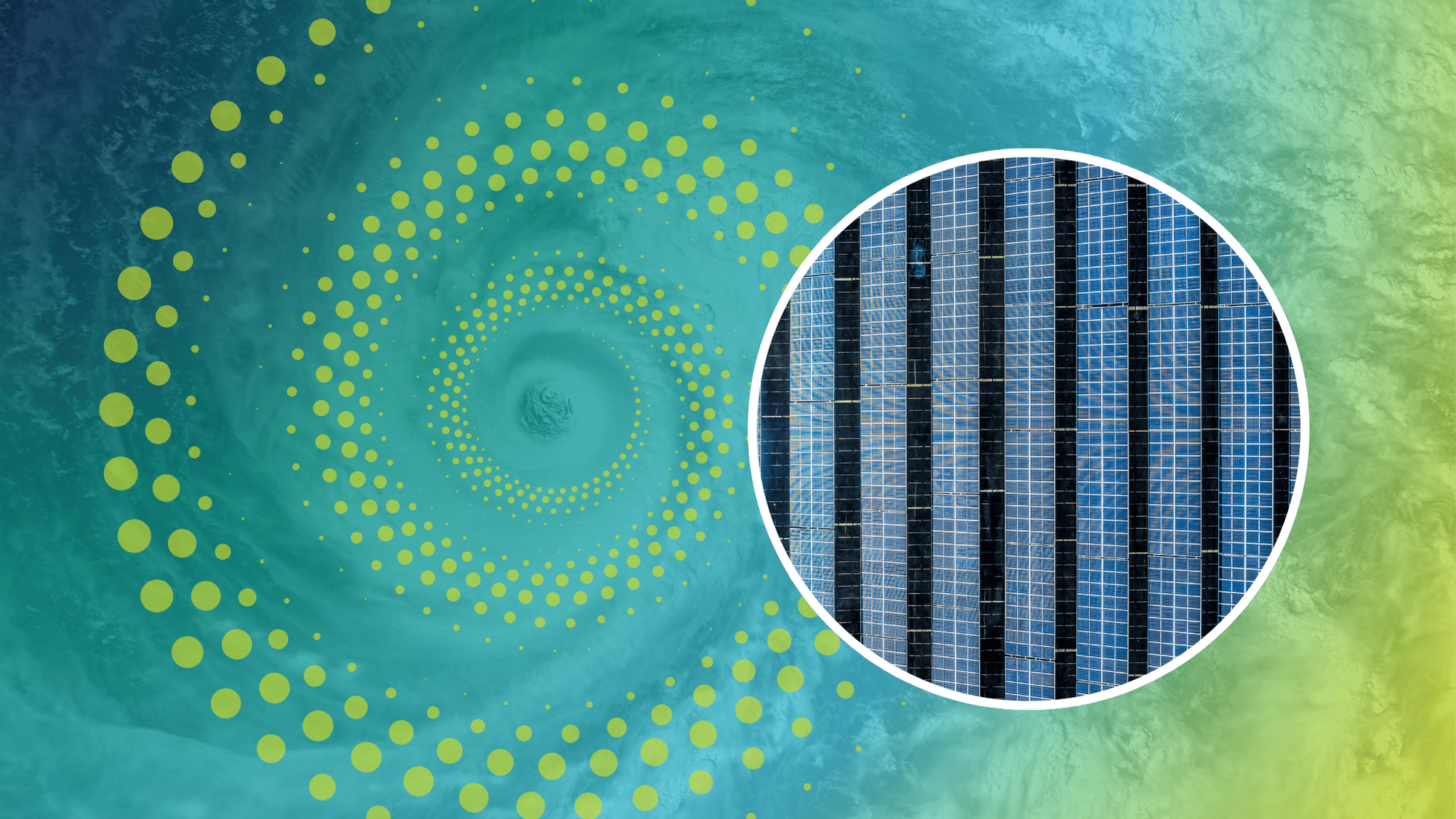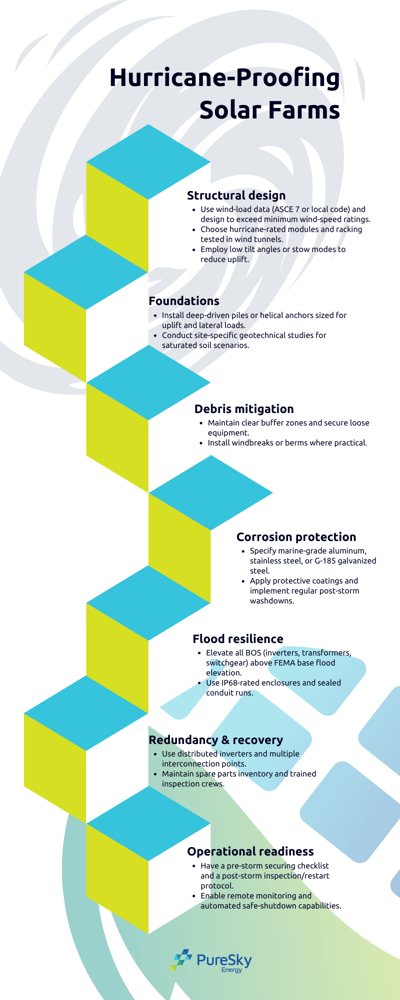How Solar Farms Stand Up to Hurricanes — And Why It Matters More Than Ever

There’s something almost poetic about a solar farm. Hundreds, sometimes thousands, of panels tilted toward the sun, quietly turning photons into power. No smokestacks, no roaring turbines, no fuel trucks pulling up at dawn. Just sunlight, silently harvested.
But as serene as that scene looks, the reality is anything but static. In the age of climate change, these fields of glass and silicon are increasingly asked to stand their ground against some of the fiercest storms on Earth: hurricanes whose winds can lift cars and whose storm surges can erase the coastline as we know it.
If we’re serious about transitioning to clean energy in hurricane-prone states like Florida, Texas, and the Carolinas, we have to answer a deceptively simple question: how do you hurricane-proof a solar farm?
The Wind Problem for Solar Farms
Start with wind. A Category 4 hurricane can bring sustained winds of 130–156 mph, with gusts even higher. That’s not a gentle shove; it’s a sustained, physics-bending assault. Panels act a little like airplane wings — the wrong tilt, the wrong spacing, and wind can get underneath, creating uplift forces that try to peel them off their racks.
Solar engineers plan for this. They begin with wind maps, often based on standards like the ASCE 7 building code, to understand the exact wind speeds a site might face over a 50- or 100-year span. They don’t stop at “code minimum.” For critical infrastructure — especially in hurricane alley — designs often aim for safety margins above the legal requirements. Lower tilt angles can reduce wind exposure. Certain racking systems are tested in wind tunnels, mimicking the chaotic turbulence of hurricane gusts.
Some farms even employ stow modes — motorized trackers that flatten panels to a horizontal position as a storm approaches, reducing both uplift and the risk of debris damage.
The Water Problem for Solar
Then there’s water. Storm surge doesn’t politely skirt the edges of a site; it floods in, carrying debris, salt, and sediment. Electrical equipment is not fond of being submerged in corrosive, silty water.
The solution isn’t complicated in theory: keep the important stuff high and dry. Inverters, transformers, and combiner boxes are mounted on raised platforms, sometimes well above FEMA’s base flood elevation. Cabling is routed in sealed conduits or elevated trays. In coastal areas, corrosion-resistant metals — galvanized steel, marine-grade aluminum, stainless steel — become non-negotiable. It’s more expensive up front, but far cheaper than replacing equipment every time the ocean decides to visit.
Fighting Debris and Corrosion
Flying debris is the silent destroyer. A tree branch or a chunk of roofing doesn’t care how strong your racking is. To prepare, companies clear vegetation and secure loose equipment before storms. Some sites even incorporate perimeter windbreaks — natural or engineered — to slow airborne projectiles.
And even if the panels survive uncracked, salt spray can quietly eat away at frames and fasteners. That’s why coastal farms rely on extra-thick galvanization, protective coatings, and regular post-storm inspections to wash down and assess the site.
Designing for Redundancy
The most resilient solar farms aren’t just strong; they’re redundant. Rather than funneling all power through a single point, many modern designs use distributed inverters and multiple interconnection points. That way, if one section goes down, the rest can keep generating once the grid comes back online. It’s a kind of energy compartmentalization — the electrical equivalent of watertight doors on a ship.
The Human Factor
We tend to think of hurricane-proofing as an engineering challenge — steel, concrete, aerodynamics. But there’s a human layer, too. Operations teams keep storm-prep checklists: secure spare panels, anchor tools, confirm communication systems, update utility contacts. After the storm, trained crews inspect every section before restart — looking for hairline cracks in panels, testing insulation resistance, checking that nothing is secretly compromised.
It’s a system, not just a structure. The difference between “damaged” and “ready to go” often comes down to how quickly that human-machine system is mobilized.
Why This Matters Beyond the Fence Line
Hurricane-proofing a solar farm isn’t just about protecting an asset. It’s about resilience for entire communities.
During Hurricane Maria in Puerto Rico, vast sections of the grid went down for months. Diesel generators kept some hospitals running, but fuel had to be shipped in, trucked over damaged roads, and rationed. In contrast, solar farms paired with batteries — and especially smaller microgrids — provided lifelines: refrigeration for medicines, power for water treatment plants, charging stations for phones.
In a future where hurricanes are expected to be stronger and wetter, the ability to keep at least part of the grid online locally, without waiting for supply chains to catch up, is not just nice to have — it’s survival infrastructure.
That’s why some forward-thinking projects are designed from the start to "island" in emergencies, feeding critical loads nearby even when the wider grid is dark. They’re built for everyday efficiency and once-in-a-decade crises.
The Quiet Shift to Resilient Power
We tend to notice solar farms most when they go up, rows of panels suddenly appearing in a field. We notice them less when they survive the storm that knocks out power for miles around. But that quiet endurance is becoming one of their most important features.
The shift to renewables isn’t just about swapping one power source for another. It’s about rethinking what we expect from our infrastructure: not just to produce electricity when the sun shines, but to stand up to the storms we know are coming — and to keep the lights on, in whatever way they can, when the sky goes dark.




